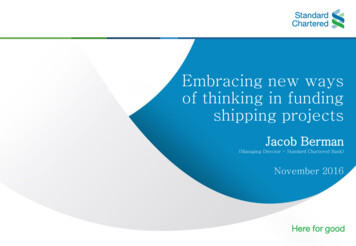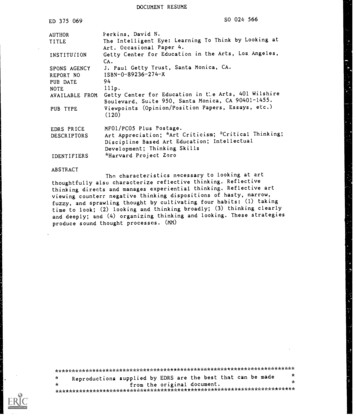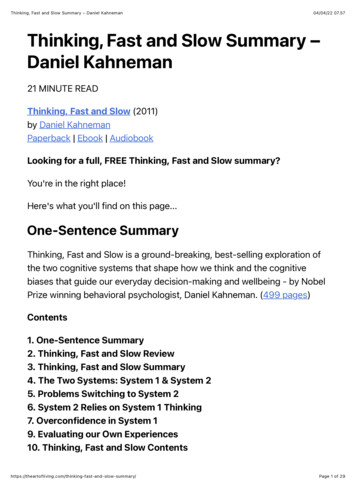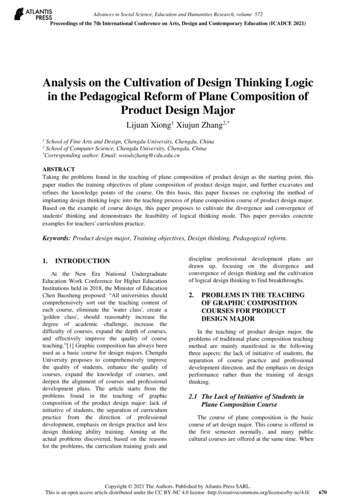
Transcription
Embracing new waysof thinking in fundingshipping projectsJacob Berman(Managing Director - Standard Chartered Bank)November 20160
Traditional Methods of Shipping Finance1Capital ProviderCapital Provider Need / PreferenceEquity StakeholdersInvestments from existingshareholders Logical decision whether to further inject“good” capital in stressed assetsMarket Trend Internal ability of business to generateadditional free cash flow to meet future capitalneeds23Secured Bank DebtSenior / subordinated debt providedby banks (bi-lateral / syndicate)using vessel as collateralStructured LeasesAn arrangement where the seller ofan asset leases back the sameasset from the purchaser Credit rating (Quality of financials)Full vs Limited recourse Floating interest rateShort / Medium TenorCollateral on modern assetsStrong management teamExisting creditor relationships Asset Class New vs Secondhand Vessel Guarantee from related entities 1
Emerging Alternatives in Shipping FinanceGaining Momentum With post-financial crises reforms (Basel III) restricting bank lending, shipping companiesare exploring alternative means of financing for new energy efficient vessels to remaincompetitive and fill the finance gap In 2008, 84% of ship finance was provided by banks, but this had fallen to 63% by 2014As per the Lloyd’s List, 4 out of 10 top financiers to shipping belong to alternative fundingorganizations. Alternative financing has become more sophisticated with private analysisand number crunching2
Shipping Finance Market TrendEmerging Alternatives1. Export credit agencies 2. Debt capital markets 3. Equity capital markets (public and private placements / 144a) 4. Private Equity / Institutional sponsors / Distressed investors 5. Japanese Equity / Debt (JOLCO, JOL) 6. Chinese Equity / Debt 3
1. Export Credit Agencies (“ECA”)ECA backed facilities providing a stable source of financing Capital Source: Export Credit Agency (ECA) is capital provided by financing entities seeking to support the shipbuilding industry. Trend: ECA financing has become one of the most popular sources of alternative funding in recent years oBefore the financial crisis, ECAs accounted for approximately 10 percent of shipping and offshore-related debt finance; now, theirshare has increased to more than 33 percent, amounting to USD 15 billion a yearoThe stability provided by an ECA-backed bond has sparked sufficient interest to support a bond deal at favorable pricing termsGenerally domestic new building vessels:oECAs are distinguished by their relationship with Government regulatory bodies. For instance, the world’s largest ECA, the ExportImport Bank of China (CEXIM), is governed by the Chinese Government. ECAs by and large focus on supporting their domesticshipbuilding industryAdvantage of Capital Market:1. Buyer is able to order a new vessel with little to no money until delivery.Parent Company[Corporate Guarantee]100%Holding Company100%Third PartySenior Secured Term Loan(ECA Tranche[ Commercial Trance])Vessel Owning SPVsVessels onTime Charter /Spot MarketCross collateralized Mortgage over Vessels, UpstreamGuarantees in addition to standard security package[X%] InsuranceCoverage on theECA TrancheECA Provider4
2. Debt Capital Markets – Conventional / IslamicBridging the funding gap with bonds Capital Source: Investors seeking the opportunity to provide debt to the shipping space through fixed income structures Investors include pension funds, insurance companies, hedge funds, and other large investors Key Types: (1) Unsecured Bond, (2) ABS & EMTC, and (3) Sukuk Trend: Bond markets are an increasingly important source of liquidity for the shipping industry, as more shipping companies areissuing bonds to increase working capital and repay bank debt. Issuance of Equity and Bonds has more than doubled from USD 9.1Bnin 2008 to USD 20.9Bn in 2014. Capital market financing (Equity/Debt) accounts for 30 percent of the total financing extended to theshipping industry. Key drivers to bond issuance:oMinimum issuance sizeoCurrenciesoAssets classoMarket LiquidityoStrong sponsor / management teamoSupport from related entities if necessaryAdvantage of Capital Markets:1. Ability to issue debt with longer maturities and fixed interest versus bank loans which typically entail a much shorter duration and arelinked to floating rates5
Debt Capital Markets – Enhanced Maritime Trust Certificates(“EMTC”)Structured Finance Bonds In 2015, United Arab Shipping Company successfully issuedGovernmentOwnersEnhanced Maritime Trust Certificates (EMTC). The issuance100%received strong interest from institutional investors in NorthAmerica, Europe and the Middle East Pricing Date: 16 Apr 2015 Facility: USD 162 Mio, Tenor 12.00 Years (WAL 7 Years) BareboatCharter Hire (1)B Share – CertainNegative Control RightsA SharesSPV(for each Vessel)Payments Under IndentureLoan TrusteeUse of Proceeds: The proceeds were used to finance thePayments on Notesdebt portion of two 2012-built 13,500 TEU container vessels Foundation(Orphan)UASCGuarantee and CrossColllateralisationOther VesselOther SPVSeries AEquipment NotesSecurity:o First priority cross-collateralized and cross-defaulted shipmortgagesClass A LiquidityProviderAdvances andReimbursementso First priority assignment of earnings under the bareboatchartersSubordinationAgentPrincipal, Interest, andMake-WholeClass ATrusteeDepositaryInterest on Deposits Security: 68% Rating: Investment Grade (Fitch, KBRA)Class ACertificateholdersEscrow AgentKeyMaltaApplicableLaw / RegionMiddle EastUSCash FlowType ofRelationshipClass A Share OwnershipClass B Share OwnershipNotes:(1) UASC leased (or chartered) Vessels from SPVs, providing its own crew, pursuant to an English law governed Bareboat Charter Agreement (a “Bareboat Charter”). Payments under theBareboat Charter are at least sufficient to make payments under the Equipment Notes. UASC will in addition pay all taxes, insurances, and maintenance costs (a “triple net” lease)(2) SPVs have the right, subject to conditions, to issue subordinated Series B Equipment Notes and to cause the issuance of subordinated Class B Certificates subsequent to the initial funding6
Debt Capital Markets - Islamic In 2015, National Shipping Company of Saudi Arabia (Bahri)Pool of WakalaAssetscompleted floating rate issue of a debut Islamic bondSale of Assets(“Sukuk Al Wakala”) Pricing Date: July 18 2015 Facility: SAR 3.9 Bn, Tenor 7.00 Years (Bullet maturity inSeller(s)5Return on6InvestmentsJuly of 2022)4WakeelSukuk ProceedsSecurity: UnsecuredSukuk al-wakala Structure (Agency Arrangement): AWakalaAgreement79ObligorIssuer SPVas Issuerand TrusteeWakala AssetsExercie Priceprincipal (the investor) appoints an agent (wakeel) to invest1funds provided by the principal into a pool of investments orassets and the wakeel lends it expertise and manages thoseinvestments on behalf of the principal for a particular28DissolutionAmt. Sale / PurchaseUndertakingsSukukProceeds Purpose: To finance the acquisition of VelaSukuk (TrustCertificates) SukukProceeds3Return onInvestmentsPricing: SIBOR rate 80ps (Floating rate issue)PeriodicDistribution Amt. 10duration, in order to generate an agreed upon profit return.InvestorsThe principal and wakeel enter into a wakala agreement,which will govern the appointment, scope of services andfees payable to the wakeel, if any.Notes: Sample structure of Sukuk al-wakala7
4. Japanese Equity / Debt (JOL & JOLCO) The JOL structure originated in March 1999 as a result of the Japanese Tax Authority’s (NTA) change in the basis uponwhich investors in a Japanese Leveraged Lease (JLL) could claim depreciation on cross-border or double dip leasesJapanese Operating Lease (“JOL”) A Japanese Operating Lease (JOL) is an operating lease funded by an equity investment from a Japanese entity and nonrecourse senior debt provided on-shore in Japan.o 100% financing of used vessels under a sale/leaseback or from a third-party lessor (with an operating lease attached)o The lease terms are generally no longer than 10 yearsJapanese Operating Lease with Call Option (“JOLCO”) Used to finance new vessels and have a minimum lease term of 10 years. Have a call option (early buyout option or EBO), and lessees often expect to exercise the call option on the EBO date. Lessees look at a JOLCOs as a debt financing, i.e. it is on balance sheet financingAdvantage of JOL /JOLCOs Offers competitive lease rates and off balance sheet financing.oThis is achievable because the owner of the vessel (i.e., the Japanese equity investor) is entitled to claim depreciationtax benefits in Japan. In order to receive the tax benefits associated with owning the vessel, the Japanese equityinvestor must accept residual value exposure as well as demonstrate knowledge and expertise of leasing8
Japanese Operating Lease (“JOL”)The flow of funds and the related loan and leaseagreements among the participants in a JOL are shown.On-shoreLender1. In a JOL, the vessel purchased by the Japaneseequity investor is often a used aircraft2. The Japanese equity investor funds approximately20-30% of the acquisition cost of the aircraft andbecomes the owner of the aircraft via a SpecialPurpose Entity called a TK3. An international bank with on-shore lendingcapabilities provides the balance of the aircraftpurchase price (approximately 70-80%) via a seniorsecured mortgage loanMortgage & SecurityAssignmentsRVG /RemarketingAgreementResidual ValueGuarantee& RemarketingAgreementLoanTK / Lessor /OwnerEquityInvestmentJapanese EquityInvestor4. The senior loan is structured such that the loan willamortize to a balloon payment due at maturity5. The Lessee pays rent to the SPC which is sufficientto pay the monthly loan payment including a minimaldividend return to the Japanese equity6. To insure the residual value of the aircraft at thelease maturity, the owner of the aircraft often entersinto an agreement with a Remarketing Agent duringthe lease negotiations to insure the sale or release ofthe aircraft and may also obtain a Residual ValueGuarantyAgreementof SaleSeller(if not Lessee)LeaseLessee9
Japanese Operating Lease with Call Option (“JOLCO”)JOLCO AdviserJapanese InvestorsTK Equity Investment100% Owned100% OwnedRemarketing AgreementRegistered OwnerInstalment – Sale AgreementSPCs(Lessor)Lender(s)Loan AgreementLease AgreementSale AgreementClient(Lessee)10
SCB Capabilities11
Extensive Shipping Finance & Lease ProductOfferings The Standard Chartered Shipping Finance team was established 2007 – 27bankers based in key global centres. In depth product knowledge and exceptional execution pedigree – teamincludes qualified ship officer, legal, tax, structuring and Islamic financingcapabilities. Established track record of delivering client-centric shipping sectorsolutions across the bank’s footprint1Range of Services Senior debt and junior debtAssets & receivables backed financing (loans & bonds)Pre-delivery payment structuresExport Credit Agency backed structuresAdvisory (procurement and new build programmes, M&A)Off-balance sheet solutionsIslamic solutionsLocal currency solutionsOperating / Finance lease structuresHedging / Financial MarketsCash Management and Transaction Banking2Vessel Coverage BulkersTankersContainershipsGas carriersOffshore vessels (E&P and marine services)Selected AwardsShipping Finance DebtDeal of the Year 2015Deal of the Year 2015Shipping Private EquityDeal of the Year – East2015BW Pacific LimitedTopaz Energy MarineLimitedGreathorse ChemicalBest TransportationFinance House 2014Deal of the Year 2014Shipping Equity Deal ofthe Year 2014Standard Chartered BankSapuraKencana / SeadrillGreathorse ChemicalShipping Innovatorof the Year 2014Debt Deal of the Year(North America) 2014Shipping LeasingInnovator of the Year 2013Standard Chartered BankPacific DrillingStandard Chartered Bank12
DisclaimerThese materials have been provided to You by Standard Chartered Bank (“SCB”) in connection with an actual or potential mandate or engagement and may not be disclosed or referred to (in whole or inpart) or used or relied upon for any other purpose other than as specifically agreed by written agreement with SCB. The information used in preparing these materials was obtained from or through You,Your representatives or public sources. While SCB has taken reasonable care in preparing these materials, SCB has not independently verified the information contained in these materials. SCB, itsaffiliates and their respective directors, officers or employees (the “SCB Group”) assume no responsibility for and do not represent or warrant the completeness or accuracy of the information (whetherwritten or oral) including estimates, projections or forecasts (of future financial performance or otherwise) referred to in these materials or that may be supplied in connection with these materials(“Information”). SCB is under no obligation to inform You or anyone about any change (whether or not known or apparent to SCB) to the Information. You must make Your own independent judgment withrespect to any matter contained in these materials. The SCB Group will not be responsible for any losses or damages which any person suffers or incurs as a result of relying upon or using these materialsor as a result of any information being omitted from these materials. These materials do not constitute an offer or commitment to arrange or underwrite any form of financing, to underwrite, subscribe for orplace any securities, or to enter into any other transaction, and do not create any legally binding obligations on the SCB Group. The SCB Group does not owe any fiduciary or other duties to You or anyother person and the SCB Group may be involved in other transactions and services with clients who may have conflicting interests with You or any other person. If You do not accept any of the conditionsabove, you must immediately return these materials and any copies of it, otherwise, the retention of these materials by You shall evidence Your acceptance of such conditions. SCB’s ability to enter intoany transaction (or to provide any person with any services in connection with any transaction) will be subject to, among other things, internal approvals and conflicts clearance. If You execute anengagement letter with SCB for the transaction referred to in these materials, the provisions of such executed engagement letter shall prevail over the conditions above, to the extent there are anyinconsistencies.SCB has adopted policies and guidelines designed to preserve the independence of its research analysts. SCB's policies prohibit employees from directly or indirectly offering a favourable research ratingor specific price target, or offering to change a research rating or price target, as consideration for or an inducement to obtain business or other compensation. SCB's policies prohibit research analysts frombeing compensated for their involvement in corporate finance transactions.Communicated by Standard Chartered Bank, Dubai International Financial Centre branch (“SCB DIFC”). Standard Chartered Bank is authorised by the Prudential Regulation Authority (“PRA”) andregulated by the Financial Conduct Authority (“FCA”) and PRA in the United Kingdom. SCB DIFC having its offices at Building 1, Gate Precinct, P.O. Box 999, Dubai, UAE is a branch of StandardChartered Bank and is regulated by the Dubai Financial Services Authority (“DFSA”). This document is intended for use only by Professional Clients and is not directed at Retail Clients as defined by theDFSA Rulebook.13
6. To insure the residual value of the aircraft at the lease maturity, the owner of the aircraft often enters into an agreement with a Remarketing Agent during the lease negotiations to insure the sale or release of the aircraft and may also obtain a Residual Value Guaranty On-shore Lender RVG / Remarketing Agreement Japanese Equity Investor Seller











